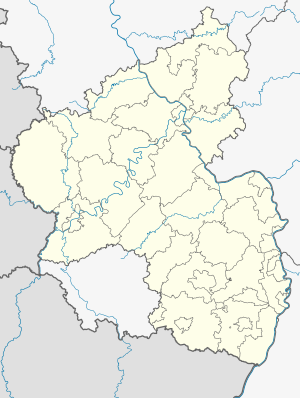Neuhof tunnel
| Neuhof tunnel | ||
|---|---|---|
| use | Railway tunnel | |
| traffic connection | Landau – Rohrbach railway line | |
| place | Rodalben | |
| length | 304 m | |
| Number of tubes | 1 | |
| construction | ||
| Client | Palatine Ludwig Railway Company | |
| start of building | 1871 | |
| business | ||
| operator | Deutsche Bahn | |
| release | November 25, 1875 | |
| location | ||
|
|
||
| Coordinates | ||
| North-west portal | 49 ° 14 ′ 13 " N , 7 ° 39 ′ 53" E | |
| South-east portal | 49 ° 14 ′ 6 " N , 7 ° 40 ′ 4" E | |
The Neuhof Tunnel is one of a total of four tunnels on the Landau – Rohrbach railway line and is the second longest after the Münchweiler Tunnel . Originally laid out as a single track, the line was expanded to double tracks in 1887, which was planned from the beginning. It has been single-track again since the end of World War II.
location
The tunnel is located in the east of the small town of Rodalben . It is used to shorten a loop of the Rodalb to cross under the Hanauische Eck . The eponymous district of Neuhof is located southwest of it .
history
In the course of the planning of the Palatinate Ludwig Railway , the route east of Bexbach was not fixed from the start. On January 10, 1838, a meeting took place in Speyer , which marked the beginning of share subscription for the route. A landowner from Wachenheim suggested that the railway line run via Zweibrücken and from there via Rodalben, Annweiler and Langenkandel to the Rhine . The written justification followed on January 20th of that year. Although the government of the Rhine district passed this on to Munich , it did not prevail. Another participant at the event argued that a corresponding route would be more cost-effective, but would bring less profit than one via Kaiserslautern .
Despite the already built railway line via Kaiserslautern, efforts were made in 1849 to build a line from Zweibrücken to Landau. However, the Palatinate Railway Administration initially refused to do this, as they feared competition with the Palatinate Ludwig Railway and the construction of the section through the Palatinate Forest would be very complex. Especially the places along the Queich pushed further in this regard.
Project drawings began in the early 1870s. A loop of the Rodalb was shortened by building a tunnel. On November 25, 1875, the main line including the structure called Neuhof Tunnel was opened to its full length after traffic between Landau and Annweiler had already been opened 14 months earlier.
The tunnel was badly damaged in World War II . The vault collapsed due to the explosion of an ammunition train or deliberate detonation by the German military in retreat. The repairs to the tunnel and two other, heavily damaged tunnels lasted until 1948, before the route was completely passable again.
From 1946 onwards, the French crew dismantled the second track as part of reparations payments. Since then, the tunnel has only been single-track.
literature
- Heinz Sturm: The Palatinate Railways (= publications of the Palatinate Society for the Advancement of Science. Volume 53). New edition. pro MESSAGE, Ludwigshafen am Rhein 2005, ISBN 3-934845-26-6 .
Web links
Individual evidence
- ↑ Heinz Sturm: The Palatinate Railways . 2005, p. 182 f .
- ↑ Heinz Sturm: The Palatinate Railways . 2005, p. 54 .
- ↑ Heinz Sturm: The Palatinate Railways . 2005, p. 177 .
- ↑ Heinz Sturm: The Palatinate Railways . 2005, p. 181 f .
- ^ Max Schweinitz: Ten years of reconstruction at the Mainz Federal Railway Directorate . In: Bundesbahndirektion Mainz (Ed.): The Bundesbahndirektion Mainz. Festschrift for the 60th anniversary of the founding of the Mainz Railway Directorate . Carl Röhrig, Darmstadt 1956 = special print from Die Bundesbahn 22/1956, pp. 53–57 (53, 57).
- ↑ queichtalbahn.beepworld.de: Chronicle from 1874 to 2000 . Archived from the original on October 16, 2013 ; Retrieved October 17, 2013 .
